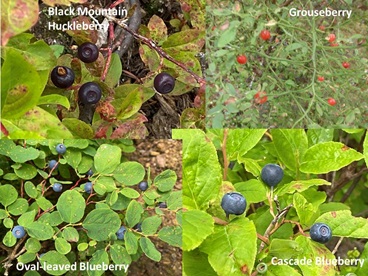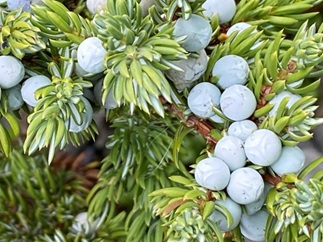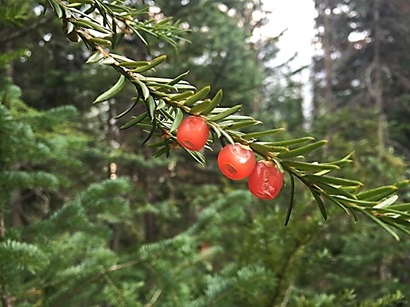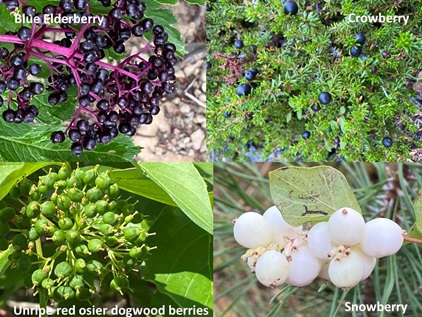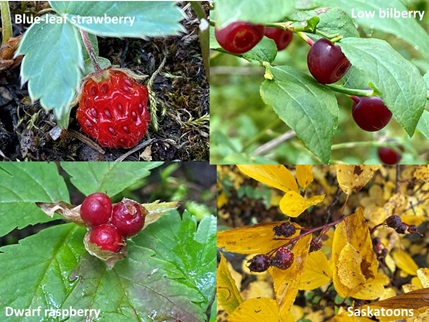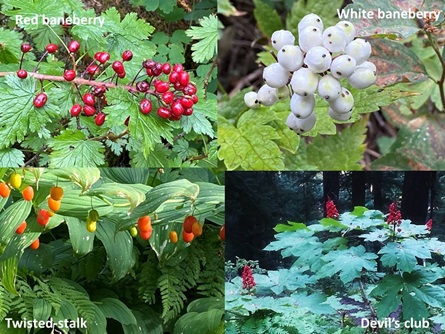By Jenny L. Feick, Ph.D.
All pictures are by the author unless otherwise credited.
Introduction
One of the most vivid images I get when I read Tales from the Great Divide is the story Dave Zevick tells about him and Cliff running out of food during a tough week of trail surveying for Project: Great Divide Trails in the summer of 1974[1]. When they entered a clearing and saw a field of wild strawberries, they fell on their hands and knees and devoured as many as they could. Recalling the delight of foraging on wild fruit in the vicinity of the Great Divide and many other areas, combined with questions I’ve received from newbie GDT hikers on the edibility of various berries, provided the inspiration for this article.
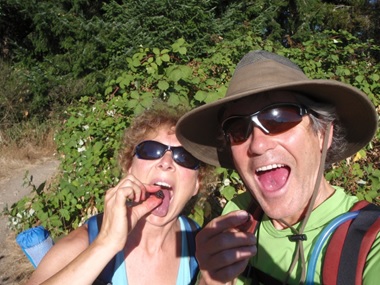
What is a Berry Anyway?
In everyday English, a “berry” is any small edible fruit. Although many small seeds may be present, berries lack the stone or pit found in other types of fruit. Most people tend to think of berries as being round, brightly coloured, juicy, a bit squishy, tasting sweet or sour, and able to be plucked off of a plant be it a forb[2], bush, or tree. People called certain fruits “berries” thousands of years before scientists developed a precise definition.
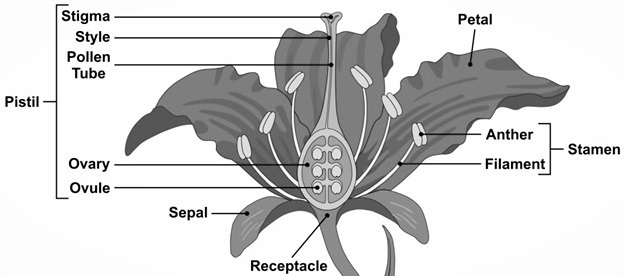
The science of botany defines a berry more precisely as a fleshy fruit without a stone (pit) produced from a single flower containing one ovary[3] that is superior[4]. The berry is the most common type of fleshy fruit in which the entire outer layer of the ovary wall ripens into a potentially edible pericarp[5]. Berries may be formed from one or more carpels[6] from the same flower (i.e. from a simple or a compound ovary). The seeds are usually embedded in the fleshy interior of the ovary. Berries all have three distinct fleshy layers: the exocarp (outer skin), the mesocarp (fleshy middle) and the endocarp (innermost part, which holds the seeds). The skin of the berry is its exocarp, its fleshy middle makes up its mesocarp and the jelly-like innards holding the seeds comprise its endocarp.
Among the wild berry-like fruits one might encounter along the GDT, crowberries, wild currants and Oregon grapes are examples of real berries[7] but many so-called berries are not true berries. This chaotic discrepancy in berry nomenclature reflects Nature’s complexity and the myriad ways plants evolved.
When is a Berry not a Berry?
The botanical definition excludes certain fruits that meet the culinary definition of berries, including Saskatoons, raspberries, and strawberries. What people commonly think of as berries may actually be drupes, pomes, aggregate or accessory fruits, capsules, or even modified conifer seed cones. Some botanists do not even consider wild cranberries, blueberries and huckleberries to be true berries, calling them epigynous or false berries, but that’s getting really picky. Regardless, any fruit that resembles a berry in texture and form, whether it actually is a berry or not, is termed “baccate”.
To be a berry, fruits must develop from one flower that has one ovary. Certain plants have flowers with just a single ovary. Blueberries meet that criterion, as do cranberries and huckleberries. The botanists who do not consider these plants to bear true berries list another criterion related to the position of the ovary on the plant. These botanists classify true berries as the ones that develop from a single ovary that is superior, i.e., attached above the other floral parts, not below. Another characteristic of a true berry is that the fruit in question must contain two or more seeds.
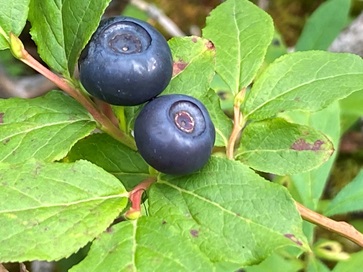
Epigynous Berries or False Berries
The term epigynous berries refer to berries that develop from an inferior ovary, i.e., one attached below the other floral parts. In these so-called false berries, they include tissue derived from parts of the flower besides just the ovary. The floral tube, formed from the basal part of the sepals, petals and stamens, can become fleshy at maturity and unite with the ovary to form the fruit. Wild examples include members of the genus Vaccinium (e.g., cranberries, blueberries, and huckleberries)[8].
Drupes
A drupe or stone fruit is a fleshy fruit with thin skin and a hard pit inside that contains a single seed[9]. In the vicinity of the GDT, the obvious drupes you might see are chokecherries or pin cherries. However, bearberries are also drupes. The common bearberry’s (Arctostaphylos uva-ursi) drupes are dry and mealy, and each contains a stone consisting of several nutlets. Each of the juicier bright scarlet drupes of A. rubra, the red bearberry, found high in the alpine, has a single stone. The squashberry (Viburnum edule) also bears a bright red and juicy drupe that is ¼ to ½ inch (0.635 to 1.27 cm) in diameter.
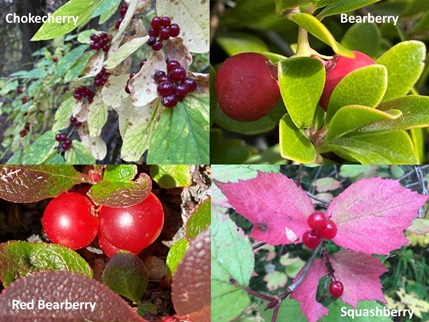
Pomes
Pome fruits are produced by certain plants in the Rose family that have a structure (the core) in which tough tissue clearly separates the seeds from the outer softer pericarp. Most common agricultural pomes (e.g., apples and pears) are obviously not berries. However, some of the smaller pomes look like and get called berries. For example, Saskatoons or serviceberries are a typical berry size and can become so soft at maturity that they resemble a berry. Nevertheless, structurally, they are pomes. When people complain of Saskatoons being mealy, it’s because of the tough core around the seeds.

Aggregate fruits
Some plants produce flowers with more than one ovary. Aggregate or compound fruits contain seeds from the different ovaries of a single flower, with the individual subunits, which are actually drupes, joined at maturity to form the complete complex fruit. Examples of aggregate fruits commonly called “berries” include members of the genus Rubus, the raspberries. Each drupe contains a seed; that’s why wild raspberries are so crunchy. Since these types of fruit consist of so many drupes, they’re called aggregate fruit. Botanically, these are not true berries.
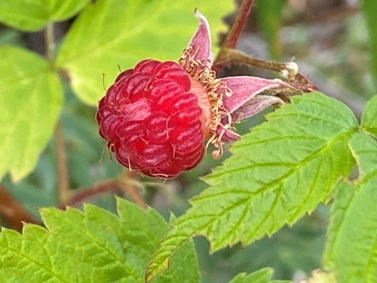
Accessory fruits
Accessory fruits are a type of aggregate fruit from a plant that bears flowers with multiple ovaries. In accessory fruits, the floral ovaries do not generate the edible part. Instead, it develops from the flower’s receptacle[10]. What is eaten is accessory tissue, hence the term accessory fruit. The wild strawberries so avidly devoured by Cliff and Davey in 1974 are perfect examples. Instead of being comprised of multiple drupes, the strawberry has a collection of little yellow ovals on its outer surface. Most people think these are the seeds on a strawberry, but they are actually modified fruits called achenes[11]. The non-fleshy aggregate of these seed-like achenes on a strawberry’s exterior is actually the “fruit”, derived from the sum total of its ovaries. The fleshy edible part of a strawberry is the accessory tissue.
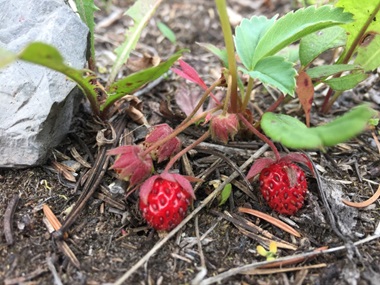
Surprisingly, buffaloberries also fit in this category. The fruit resembles a drupe, but in this case, the ovary matures as an achene (dry seed), and the fleshy fruit is really the swollen calyx (the sepals).
Capsules
Some types of plants produce dry capsules, which are notable by opening along three or more lines at the top of the fruit to release their seeds. Members of the Lily family produce capsules.
Berry-like Conifer Seed Cones
The female seed cones of some conifers have fleshy and merged scales, giving them a berry-like appearance. All three species of juniper found along the GDT[12] produce these so-called juniper “berries”, which are more correctly termed fleshy cones. Usually, one bite into one of these strong tasting and pitchy cones is enough to convince most people that it’s inedible[13].
The seed cones of species in the Yew family have a bright colour when fully developed, increasing their resemblance to true berries. Instead of the woody female seed cone typical of coniferous trees, the reproductive structure of the Western (Pacific) yew (Taxus brevifolia) consists of a single seed that becomes surrounded by a fleshy, scarlet cup-like covering called an aril[14]. This bright red covering, derived from a highly modified cone scale, is edible. However, each of these mistakenly called “yew berries” encloses a very poisonous seed, which can induce vomiting, dizziness, difficulty breathing, tremors, and changes in heart rate. If untreated, it can cause death. The needles are also toxic. The bark of the Pacific yew tree provided the basis for an effective cancer treatment[15]. Pacific yew trees can only be found in a few locations along the GDT on the west side of the Great Divide.
How Did Berries Evolve?
Over the millennia, flowering plants devised myriad ways to produce and broadcast their seed. Bearing fleshy edible fruit is Nature’s way to entice getting animals to consume and distribute their seeds, thus perpetuating that species.
Berries and other fleshy berry-like fruits have only been on planet Earth for the past 66 million years. The first fossil evidence of baccate fruits appeared by the end of the Cretaceous Period and the beginning of the Paleogene Period as most of the mammal species found today began to appear. Large fleshy fruits tend to be associated with moist habitats with closed tree canopies, where wind dispersal of dry fruits is far less effective. These habitat types became increasingly common during the 43 million years of the Paleogene. The associated change in fruit type may have led to the evolution of fruit eating in mammals and birds. The increasing importance of seed dispersal by fruit-eating vertebrates, including reptiles, birds, and mammals, may also have driven the evolution of fleshy fruits like berries.
Identifying the Good, the Bad and the Deadly
Many wild berries are edible and delicious (See Table 1). Others are edible but not desirable unless specially prepared (See Table 2). Others, such as baneberries and Devil’s club berries, are toxic to humans even though other mammals such as grizzly bears can eat them (See Table 3). Also, just because you have read that some First Nations made/make use of a baccate fruit does not mean it is safe for you to eat. Indigenous peoples have time-tested traditional ways to safely harvest and prepare the food. With all this in mind, here are some guidelines to follow to stay safe when foraging for wild berries.
- Bring and use plant identification information when going to new environments. With the huge variety of wild berry-like fruits, identifying the species and its edibility can be challenging and even overwhelming. If you are going on a day hike or even a longer expedition on the GDT, carry a book[16] or use an app[17] with the names, pictures, and descriptions of bacciferous or baccate plants, i.e., plants that bear berries, to help you figure out which species you are observing and contemplating devouring.
- Never eat a berry you can’t identify. When in doubt, don’t eat any unidentified wild berries. It is not worth the risk of getting sick for the small amount of calories in such berries. Diarrhea, vomiting, and nausea will strip you of vital fluids and sugars, placing you in greater danger than you would have been without the berries. Just because you see another creature eat a berry does not mean they are safe for humans to eat, even if that animal is a mammal. Other species have different digestive enzymes enabling them to ingest berries toxic for Homo sapiens.
- Stay away from berries on plants with spines, bitter smells, or milky sap. Usually, these plants are not safe for humans to eat, including the berries. Check for: milky or odd-colored saps; berries or nuts in pods and bulbs; bitter or soapy taste; spines or small pointy hairs; pink, purple, or black spurs; or three-leaved growth pattern (like wild sarsaparilla or poison ivy).
- Avoid eating white, yellow, and green berries. In most cases, these three colors indicate poisonous berries. While a knowledgeable hiker might be able to name or find some exceptions, the best approach is to avoid all white, yellow, and green berries unless you’re sure they are edible. This advice applies when a so-called edible berry is one of these colours as it indicates that it is not yet ripe. Many unripe fruits carry toxins, which dissipate once the berry ripens fully. For example, when the blue elderberries are green they contain very toxic chemicals that will cause stomach distress and even death if consumed. Even with red berries, there’s a 50:50 chance the berries are safe to eat. If you see red berries in clusters, they tend to be toxic or inedible. Solo red berries are usually okay but not always. In general, in the vicinity of the GDT, aggregated “berries” (i.e., raspberries) are safe to eat, and most blue or black berries are edible. There are, however, some exceptions such as Queen’s Cup or blue-bead lily.
Be Berry Careful!
Two Tests for Edibility
If you believe that you must eat something in a survival situation, there are two tests to check to see if a berry-like fruit is edible. Both require patience and restraint.
1. Crush the berries to test the juice on your forearm, lips, and tongue. See if the juices cause any irritation. First, crush the berry on your arm, waiting five minutes or so to see if you get irritated. Then repeat the process on your lips and gums. Finally, chew a berry for 10-15 minutes, but don’t swallow it. If none of this causes irritation, move on to the next step. Only test one berry at a time. Otherwise, these tests are useless since you won’t be able to tell which of the two berries is causing the problem.
2. Eat 1-2 berries and wait 20 minutes. Eat slowly, seeing how your body reacts. If you’re going to get sick, symptoms (see below) will appear within 20 minutes. Nevertheless, even if you feel fine after 20 minutes, keep eating slowly. Pace the berries out over a long time to prevent any toxins from gathering and give you time to adjust or note problems. If the berry tastes terrible, don’t eat it.
Symptoms of Berry Poisoning
If you insist on consuming unidentified berries, know the symptoms of berry poisoning. You could experience intense digestive disturbance and nervous symptoms. If you experience any of the following symptoms within a few hours of eating the berries, see a doctor immediately: nausea, vomiting, dizziness, diarrhea, convulsions, blurred vision, or abdominal cramps. When passing through private lands or some of the provincial Crown lands which have been sprayed with herbicide, pesticides, or other chemicals, avoid eating any berries coated with these toxins. Rinse off any berries in clean water to render them safer. Chemically poisoned berries can create the same symptoms as poisonous ones.
The Ethics of Berry Picking
Berry-like fruits have been a valuable food source for humans since before the start of agriculture, and remain among the primary food sources of other primates. No doubt about it, there is something primal about eating wild berries plumped up by the rain and warmed by the sun. Taking a berry break along the GDT can generate pure joy.
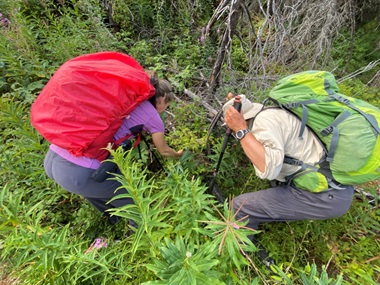
While consuming wild berries has its benefits, please be sensitive to the whole bush or forb. These plants have just invested most of their life energy to produce these ripe and succulent fruits and they depend on the dispersal of the seeds in the berries to reproduce. Respect the plant and try to cause as little damage as possible. Indigenous peoples put in place rules and practices to respect, honour and sustain berry patches over thousands of years, a tradition we would be wise to continue.
When you gather, collect no more than ten percent or less of the berries you see in an area. Consider other hikers who may appreciate a few ripe huckleberries on their instant oatmeal the next morning, as well as all the birds and mammals that live there that depend on those berries for their survival. For example, the late summer berry season is vital for bears. This is the time they enter a state of nearly constant eating and drinking called hyperphagia to prepare for their winter dormant period. Berries offer a high-calorie and vitamin-dense food source for these foraging omnivores. Black bears need to eat up to 20,000 calories per day to bulk up before entering their dens. Grizzly bears require more, up to 58,000 calories daily. A large, male grizzly can eat as many as 200,000 berries in a single day.
Parks Canada wildlife specialists warn that, due to the intensity of foraging in the late summer and early fall, bears are less likely to notice people nearby. This makes proven safety measures such as traveling in groups, carrying bear spray, and frequently making noise even more crucial to continued safe coexistence. When planning where to locate the GDT, try to situate the path away from dense patches of buffaloberry bushes. Trail crews will need to establish good sight lines in areas that pass through areas where buffaloberries grow. As a hiker, think twice before spending much time foraging in a bear’s favourite berry patch.
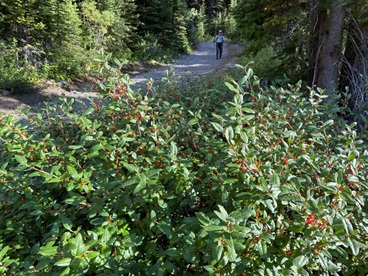
The Future of Berries Along the GDT
Back in 1811, North West Company fur trader and explorer Alexander Henry the Younger named a river the “Blaeberry Torrent” after the abundant berry bushes seen lining its bank. These were likely huckleberries, which in Scotland, were called blaeberries. “Blae” means bluish in colour, of a dark colour between blue and grey. At that time, the Northern Hemisphere was still in the grip of the Little Ice Age, with average global temperatures dipping 1 degree C below pre-1450 levels. This resulted in exceptionally severe winters in western North America, advancing glaciers, and expansion of spruce forests and ericaceous shrubs, including the huckleberries and blueberries that the Scottish fur traders called blaeberries. Today, hikers travelling through the Blaeberry Valley to and from Howse Pass can still see the berry bushes honoured in the place name, but in recent years, one can see that many are stressed by drought and higher than normal temperatures.
Climate change affects the range of where different baccate species can live as well as wild berry production. A 2019 study by University of Calgary researchers forecasts that hotter temperatures in the Northern Rockies in Canada could lead to a troubling mismatch between bears’ peak foraging weeks and the height of buffaloberry season. Their analysis revealed that in as little as 60 years, buffaloberries could ripen as much as three weeks earlier, with these temporal shifts more extreme at higher elevations. In Banff National Park, wildlife specialists reported that the hot arid conditions in 2021 and 2022 led to an 80% reduction in the buffaloberry crop from its 2020 level. Those years also saw low production of Saskatoons, blueberries and huckleberries. This threatens the bears’ historical reliance on berries in Canada’s Rocky Mountains.
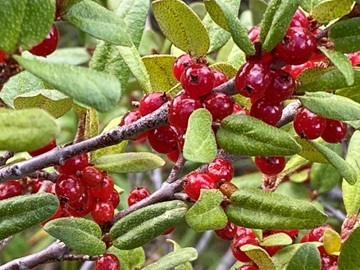
As plants respond to changing temperatures by producing berries earlier, bears will have an increasingly shorter window in which to feed on one of their key food sources. They will seek out alternate calorie sources, some of which, like garbage or spilled grain on railway tracks, could bring them into life-threatening conflicts with people.
Backpacking early or late in the season further north along the GDT across the Blueberry Alpine route and by Blueberry Lake one can still capture what it may have felt like for people travelling through the Great Divide area before the period of global climate change we are currently experiencing. Appreciate the frosty nights and cold damp days, as those conditions maintain the blueberries for which the area is named as well as other berry-like fruits along the GDT.
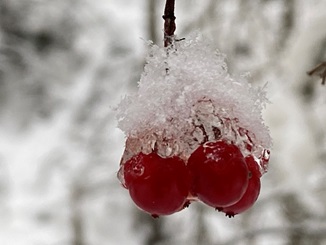
Species of Edible Berry-like Fruit You Might Encounter along the GDT
| Family | Common Names | Scientific Name | Appearance | Taste/Texture | Fruit Type |
| Honeysuckle family | High-bush cranberry or squashberry | Viburnum edule or Viburnum opulus | Round shiny red to orange | Pungent, tart, soft; palatable only after a frost with one large flat seed/fruit | Drupe |
| Crowberry family | Crowberry | Empetrum nigrum | Globular purplish or black, growing singly along the stem or in clusters of 2-5 | Thirst-quenching when ripe; can be somewhat acidic and acrid; taste better after a frost | True Berry |
| Heather family | Dwarf blueberry | Vaccinium caespitosum | Globular, light blue to blackish blue berries with a pale waxy coating, 6-8 mm in diameter | Sweetest, best-flavoured kind of blueberries | Epigynous Berry |
| Heather family | Mountain bilberry or black mountain huckleberry, black huckleberry or twin-leaved huckleberry | Vaccinium membranaceum | Large shiny, spherical, dark purple or black berries with no waxy coating | Sweet, thirst-quenching | Epigynous Berry |
| Heather family | Canada blueberry | Vaccinium myrtilloides | Medium sized blue berries with a waxy film that grow in clusters | Sweet | Epigynous Berry |
| Heather family | Low bilberry | Vaccinium myrtillus | Spherical, 5-8 mm in diameter, varying from dark red to blue-black, without a waxy coating | Juicy and sweetish | Epigynous Berry |
| Heather family | Oval-leaved blueberry or mountain blueberry | Vaccinium ovalifolium | Good-sized, dark blue but usually covered with a thick, waxy coating that gives them a greyish appearance | Good flavor but rot or go mouldy easily; also have coarser seeds than other blueberries | Epigynous Berry |
| Heather family | Bog cranberry, wild cranberry or moss cranberry | Vaccinium oxycoccus | Round to somewhat elongated, remain hard and green until after first frost when they turn red and soften | Tart with a hint of sweetness like commercial cranberries | Epigynous Berry |
| Heather family | Grouseberry | Vaccinium scoparium | Tiny (up to 5 mm across) bright red berries | Sweet | Epigynous Berry |
| Heather family | Low-bush cranberry, mountain cranberry, or rock cranberry | Vaccinium vitis-idaea ssp. Minus | Bright red berries up to 1 cm in diameter | Tart tasting and hard until exposed to frost; soft when ripe and acidic | Epigynous Berry |
| Gooseberry family | Northern black currant or wild black currant | Ribes hudsonianum | Oval, 7-12 mm long, black, berries covered with a whitish waxy coating and in upright clusters | Somewhat bitter and unpalatable | True Berry |
| Gooseberry family | Mountain gooseberry | Ribes irriguum | Round, smooth, reddish purple to deep bluish-purple or purplish-black berries in drooping clusters of 2-4 | Very sour when green; good flavor when ripe but they don’t last | True Berry |
| Gooseberry family | Smooth gooseberry | Ribes oxyacanthoides | Round, smooth, reddish purple to deep bluish-purple or purplish-black berries | Good flavor when ripe; otherwise sour | True Berry |
| Gooseberry family | Swamp gooseberry or prickly currant | Ribes lacustre | Small, clustered, dark purple to blackish berries; spiny and covered with tiny stiff black bristles | succulent sweet-sour | True Berry |
| Rose family | Saskatoon berry or service berry | Amelanchier alnifolia | Small to large fruit; reddish-purple to dark blue when ripe | Vary from sweet and juicy to dry and quite seedy to tart | Pome |
| Rose family | Red hawthorn | Crataegus columbiana | Bright red fruit hangs in clusters | Mealy texture, large seeds, pleasant but bland flavour | Pome or Haw |
| Rose family | Black hawthorn | Crataegus douglasii | Shiny black fruit hangs in clusters | Mealy texture, large seeds, pleasant but bland flavour | Pome or Haw |
| Rose family | Tall strawberry | Fragaria vesca | Pink or red fruit when ripe with tiny light-coloured achenes | Soft, delicious, bursting with flavour | Accessory Fruit |
| Rose family | Blue-leaf strawberry | Fragaria virginiana | Globular, bright red fruit at ground level | Soft, juicy, flavourful | Accessory Fruit |
| Rose family | Pin cherry or bird cherry | (Prunus pensylvanica) | Slightly elongated, 8-12 mm in diameter, bright red to almost black fruits | Usually tart but not bitter; juicy, small stone | Drupe |
| Rose family | Dwarf raspberry | Rubus pubescens | Red | Sweet, juicy, soft, seedy | Aggregate fruit |
| Rose family | Creeping raspberry | Rubus acaulis | Reddish to dark purple | Sweet, juicy, soft, seedy | Aggregate fruit |
| Rose family | Trailing wild raspberry | Rubus pedatus | Bright red with only 2-5 druplets each | Sweet, juicy, soft, seedy | Aggregate fruit |
| Rose family | Wild raspberry | (Rubus idaeus) | Bright red or occasionally yellow | Tender texture, sweet delicate taste and a pleasant aroma | Aggregate fruit |
| Rose family | Thimbleberry | (Rubus parviflorus) | Fruit turns from green to whitish pink to bright red as it ripens; shallowly cup-shaped | Extraordinarily soft, juicy and fragile; usually sweet and tasty, sometimes dry with tiny seeds | Aggregate fruit |
Species of Berries Needing Cooking or Other Special Preparation Before You Can Eat Them Safely
| Family | Common Names | Scientific Name | Appearance | Taste/Texture | Pages |
| Lily family | False Solomon’s seal | Smilacina racemose | Numerous mottled green and brown berries form, becoming red when ripe | Extremely sweet, like saccharin or syrup, very seedy | Capsule |
| Lily family | Star-flowered false Solomon’s seal | Smilacina stellate | Two to eight large berries that are green with red stripes when unripe, eventually ripening to red | Extremely sweet, like saccharin or syrup, very seedy | Capsule |
| Barberry family | Oregon grape or mahonia | Mahonia aquifolium | Round, dusty blue-black berries, resembling grapes | Sour, seedy (3-6/berry) | True berry |
| Honeysuckle family | Blue elderberry | Sambucus cerulean | Clusters of tiny (1/8-1/4” in diameter), dark blue berries (or powder-blue due to whitish waxy coating) | Not overly sweet, tart, earthy, bright; over 50% of the berry is filled with its seed | Drupe |
| Dogwood family | Red-osier dogwood | (Cornus sericea or Cornus stolonifera) | Clustered berries are green when unripe, turning white with a blueish tinge as they ripen in August; each drupe has a small spot at the end | Soft when ripe and extremely bitter | Drupe |
| Oleaster family | Soapberry or Canada buffaloberry | (Shepherdia Canadensis) | Currant-sized scarlet-red or golden-yellow berries that turn bright red when ripe | Tart, somewhat bitter, an acquired taste | Accessory Fruit |
| Heather family | Creeping snowberry | Gaultheria hispidula | Small white, oval, slightly hairy berries | Juicy, sweet, mild wintergreen fragrance | Drupe |
| Heather family | Kinnikinnick or bearberry | Arctostaphylos uva-ursi | Dull orangey red to bright red, 7-10 mm broad | Insipid, dry, hard, mealy texture | Drupe |
| Heather family | Red bearberry | Arctostaphylos rubra | Bright scarlet and shiny when ripe | Succulent, tart | Drupe |
| Rose family | Sitka Mountain-ash | Sorbus sitchensis | Initially green, then orange, turning red when ripe, in flat clusters | Extremely bitter and unpleasant with a hard crunchy texture; astringent; best after a few hard frosts | Pome |
| Rose family | Choke cherry or wild cherry | Prunus virginiana | Red to purple or dark black, shiny, ovoid, 8-11 mm long, in long hanging clusters | Sweet but astringent until fully ripened by a frost; medium stone | Drupe |
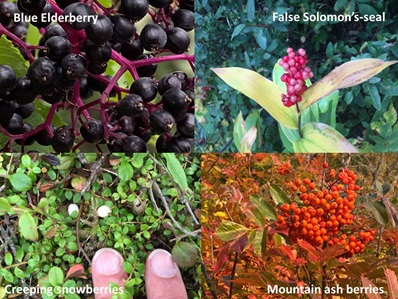
Poisonous and Inedible Berries To Avoid Along the GDT
| Family | Common Names | Scientific Name | Appearance | Taste/Effect | Fruit Type |
| Lily family | Queenscup or bluebead lily | (Clintonia uniflora) | One single egg-shaped berry (6-12 mm round), metallic dark blue in colour | Foul tasting; may cause vomiting, diarrhea, loss of appetite, lethargy, and dehydration | Capsule |
| Lily family | Claspleaf twisted stalk | Streptopus amplexifolius | Dark yellowish to red berries, many-seeded, oval-oblong, 10-12 mm long. Seeds about 3 mm long | Bland cucumber like taste; cathartic powerful purgative or laxative effect, causing severe evacuation | Capsule |
| Lily family | Small twisted stalk | Streptopus streptopoides | When ripe, each red, oval berry is up to 15 mm long | Bland cucumber like taste; cathartic powerful purgative or laxative effect, causing severe evacuation | Capsule |
| Aralia Family | Devil’s club | Oplopanax horridus | Conical cluster of small (about .25 inches in diameter and 4 mm long) bright, shiny, red flattened berries with pits, arranged in a large terminal pyramidal clusters. Each drupe has 2-3 seeds. | Acrid and toxic | Drupe |
| Honeysuckle family | Twinflower honeysuckle or black twinberry | Lonicera involucrate | Fruits are roundish or oval, shiny, black berries, paired on long axillary stalks and distinct; ripening August or September | The soft fruit tastes sweet at first but has a disgusting sour or bitter aftertaste; emetic and cathartic; the plant is notorious for absorbing toxins from the ground and nearby water | True Berry |
| Honeysuckle family | Waxberry or snowberry | Symphoricarpos albus and Symphoricarpos occidentalis | White, round, soft and opaque drupes, 1 cm across | Slight wintergreen flavor, spongy texture; the drupes contain two nutlets as well as alkaloids that cause mild symptoms of vomiting and dizziness | Drupe |
| Dogwood family | Bunchberry or dwarf dogwood | (Cornus canadensis) | The scarlet red, waxy-looking drupes are oblong in shape and displayed in clusters of 3-6 berries | The drupe is bitter, considered inedible, and will cause minor irritation if ingested | Drupe |
| Buttercup family | Red baneberry | (Actaea rubra) | In July and August, a red, opaque, shiny berry develops with a tiny black dot at the end. Each berry also has its own elongated thin stem. | The berries are acrid and poisonous causing dizziness, stomach cramps, headaches, vomiting, and diarrhea. As few as 5 or 6 of them can cause serious illness or death, causing respiratory distress and sending the heart into cardiac arrest. | Drupe |
| Buttercup family | White baneberry | (Actaea rubra f. neglecta) | In July and August, a white, opaque, shiny berry develops with a large conspicuous black dot at the end. Each berry also has its own elongated thick stem. | The berries are acrid and poisonous causing dizziness, stomach cramps, headaches, vomiting, and diarrhea. As few as 5 or 6 of them can cause serious illness or death, causing respiratory distress and sending the heart into cardiac arrest. | Drupe |
Nature Quiz Answer: Avoid eating blue elderberry drupes raw. They must be cooked first to render them safe to consume. Avoid eating any green unripe berries. While red osier dogwood berries are edible when ripe, they can cause some gastrointestinal distress if consumed in excess. Do not consume snowberries, which contain alkaloids that can induce vomiting and dizziness. The only berry safe to eat in this collage is the crowberry.
[1] See page 85 in the Second Edition of Tales from the Great Divide.
[2] A forb is a herbaceous flowering plant that is not a graminoid (grass, sedge, or rush). The term is used in biology and in vegetation ecology, especially in relation to grasslands and understory. Typically these are dicots without woody stems.
[3] In botany, an ovary is the enlarged basal portion of the pistil, the female organ of a flower. The ovary contains ovules, which develop into seeds upon fertilization. The ovary itself will mature into a fruit, either dry or fleshy, enclosing the seeds.
[4] An ovary attached above other floral parts is termed superior; when it lies below the attachment of other floral parts, it is called inferior. It has nothing to do with its quality or status.
[5] A pericarp is the part of a fruit formed from the wall of the ripened ovary. The suffix “carp” carp stems from the word “carpel,” which refers to the pistil, the female organ of the flower.
[6] Carpels are evolutionary modified leaves that bear seeds and comprise the innermost whorl of a flower. One or more carpels make up the pistil. Fertilization of an egg within a carpel by a pollen grain from another flower results in seed development within the carpel.
[7] In terms of agricultural fruits, besides currants, true berries include grapes, tomatoes, and eggplants (aubergines).
[8] Common agricultural fruits sometimes classified as epigynous berries include bananas, coffee, and members of the family Cucurbitaceae (gourds, cucumbers, melons and squash).
[9] Peaches, nectarines, plums, apricots, and cherries are examples of stone fruit or drupes.
[10] A flower’s receptacle is the thickened part of a stem (pedicel) from which the flower organs grow
[11] An achene is a type of simple dry fruit produced by many species of flowering plants. Achenes are monocarpellate (formed from one carpel) and indehiscent (they do not open at maturity). Achenes contain a single seed that nearly fills the pericarp, but does not adhere to it. In many species, what is called the “seed” is an achene, a fruit containing the seed. The seed-like form is due to the hardening of the fruit wall (pericarp), which encloses the solitary seed so closely as to seem like a seed coat.
[12] Common juniper (Juniperus communis) and creeping juniper (J. horizontalis) are shrubs and the Rocky Mountain juniper (J. scopulorum) is a tree.
[13] While juniper fruit is well known in Europe and North America as a flavouring for gin and beer and as a culinary spice, Indigenous use of juniper “berries” in Canada’s Rocky Mountains was very limited.
[14] An aril is a specialized outgrowth from a seed that partly or completely covers the seed.
[15] Taxol® (NSC 125973) Paclitaxel, the most well-known natural-source cancer drug in North America, was originally derived from the bark of the Pacific yew tree (Taxus brevifolia). Used in the treatment of breast, lung, and ovarian cancer, as well as Kaposi’s sarcoma, the estimated 5-year overall survival rates in a 2005 study published in the New England Journal of Medicine were 86.5% for the group receiving paclitaxel every three weeks and 89.7% for the group receiving weekly paclitaxel.
[16] Two useful books are Pojar, Jim and Any MacKinnon. 2013. Alpine Plants of British Columbia, Alberta & Northwest North America. Edmonton, Alta.: Lone Pine Publishers, 528 pages and Turner, Nancy J. 1997. Royal British Columbia Museum Handbook Food Plants of Interior First Peoples. Vancouver, B.C.: UBC Press, 215 pages.
[17] iNaturalist (https://inaturalist.ca/ ) and Seek (https://www.inaturalist.org/pages/seek_app)


